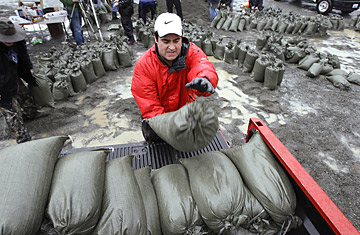
A volunteer stacks sandbags for flood control in Washington
Forty-eight years ago to the week, John F. Kennedy issued a call to national service using a still novel technology for political communication: television. "Ask what you can do for your country," he commanded from the Capitol's steps in his Inaugural Address, words that would inspire a generation of leaders to enter government service.
Now Barack Obama is reprising the call to service. But rather than using television, he has sent out his message primarily over the Internet, through millions of e-mails, hundreds of thousands of YouTube views and a new social-networking site created by his Inaugural committee. "I will ask all Americans to make a renewed commitment to serving their community and their country," the President-elect announced this week in a video posted online. "Just visit USAService.org to find service projects in your community, or even organize your own around the causes you care about." (See 21 ways to serve America.)
Obama's plan is to recruit hundreds of thousands, if not millions, of people over the coming Martin Luther King Day weekend to do volunteer work in their communities — anything from senior-center visits to mural paintings to attendance at a vigil protesting China's role in the Darfur genocide. Groups as diverse as the National Center for Transgender Equality and James Dobson's Focus on the Family are taking part, with 8,500 events nationwide listed on the site as of Wednesday. "It's an effort to emphasize the fact that people have to take responsibility for their own government," explains Marshall Ganz, a Harvard professor and community organizer who has worked with the Obama campaign.
It is also one of the first major efforts of the nascent Obama Administration to harness the power of the Internet to increase citizen participation. During the campaign, Obama's team vowed to create a "Craigslist for service" along the lines of the Obama campaign's social-networking site, MyBarackObama.com. "We believe that real change can only come from the bottom up," Obama said in late 2007 on a visit to Silicon Valley. "And technology empowers people to come together to make that change." Indeed, rather than centrally control the flow of information, USAService.org has opened itself up to users to post and organize their own events with minimal supervision.(Read "The Case for National Service.")
The website is the first explicitly nonpolitical organizing effort by Obama, who first entered politics after years spent as a community organizer. But even if the call to service is patriotic and not partisan, the effort could pay real political dividends for Obama down the road. For one thing, the organizing effort is doubling as a way to keep many of the grass-roots groups from Obama's campaign active. "We've been able to use the Barack Obama brand," says Kristopher Irizarry-Hoeksema, a former volunteer from the Obama campaign who is helping to grow a community group outside Baltimore.
His group, Randallstown for Change, has used the campaign's databases to stay organized and has begun working with local black churches and other community groups to plan a local health fair for later this summer. The Randallstown group has partnered with Urban Influence magazine, which targets black professionals, to organize a training session in Baltimore on the Saturday before Inauguration for community groups, withworkshops on everything from the civil rights of protesters to the use of stock proxies in engaging corporations. Political events like this will take place alongside apolitical blood, food and book drives. (There are 81 events listed within a 10-mile radius of Baltimore as of Thursday.)
It is too early to tell how Obama's call to service will perform when put up against other great presidential pleas of the past. Long after Kennedy, President George H.W. Bush spoke out about "a thousand points of light," and President Bill Clinton founded AmeriCorps to recruit more young people into public service. All those efforts were relatively effective, for a time. But never before has a sitting President put so much faith in new technology to make it all happen.
See pictures of Inauguration Balls past and present.
See pictures of Barack Obama's inaugural train ride to Washington, D.C.
